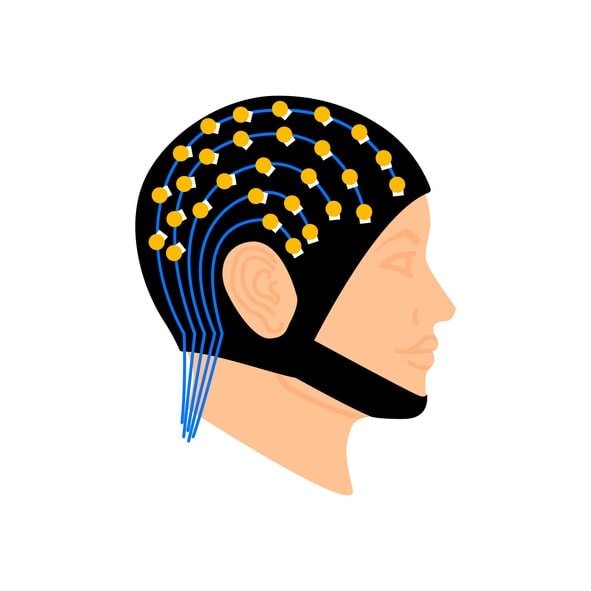Talking to babies: How face-to-face communication helps infants “tune in”…and mirror our brain activity


How do children learn the secret of good communication? It can’t be too easy, because the world is rife with misunderstandings and crossed signals. Too often, people go through the motions of exchanging information, but never really listen to each other.
In recent years, researchers have looked to the brain for answers. They’ve confirmed that good communicators don’t just trade words. They also mirror each other’s brain activity patterns. And nonverbal cues may play a crucial role during the process. So talking to babies is important, but it isn’t — by itself — enough to establish a high quality, “brain-to-brain” connection.
How do we know these things, and what, exactly, do we need to do to help babies “tune in”? Here are the details: What researchers have learned about brain-to-brain synchrony.
What is “brain-to-brain synchrony”?
Also called “neural synchrony” or “inter-brain neural synchronization,” brain-to-brain synchrony describes the tendency of two brains to engage in similar patterns of activity at the same time.
One example is when you watch a scary movie with a companion. When a monster pops out, you both experience a startle reflex, jumping in your seat, gasping involuntarily, maybe even feeling fear. Your physiological reactions and emotional responses parallel each other — what researchers call physiological and behavioral synchrony. But of course these reactions are the the result of brain activity, and so we’d expect to see some similarity in your patterns of brain activity, too.
This type of brain-to-brain synchrony is non-interactive, in the sense that you aren’t necessarily communicating with the person next to you in the movie theater. But because you tend to respond to similar environmental triggers in similar ways, your brains will tend to synchronize. You’re both processing the same type of information, with similar biological machinery.
Another type of synchrony is interactive — what happens when you are directly engaged with your companion. Maybe one of you is talking. Maybe you both are. Or maybe you’re communicating nonverbally — with facial expressions or gestures. Regardless, there are messages being sent, and it makes sense that this would also give rise to inter-brain synchrony.
For instance, if you tell me, “I missed my train,” your words are accompanied by thoughts and feelings, and a lot of processing in the language centers of your brain. When I hear you speak the words, I use my own language centers to decipher your message. I may observe your emotional cues as well, and even feel some empathic, second-hand frustration for you — the result of activitating some of the same parts of the brain that you are using to tell your story.
How can we tell if neural synchrony is happening?
One way is to record changes in blood flow to the brain — something researchers can do with the help of functional magnetic resonance imaging (fMRI). This method allows us to see which parts of the brain are most active at any given time, but collecting the data is a hassle. Your study subjects have to be willing and capable of lying still in a tube…while hearing lots of weird, loud noises. As you can imagine, this isn’t baby-friendly, or even child-friendly. So fMRI studies are usually focused on adult subjects.

By contrast, it’s a lot easier to track brain activity via electroencephalography (EEG) and functional near-infrared spectroscopy (fNIRS). Study subjects wear caps (of electrodes or sensors), but otherwise are free to move around and interact with each other.
No matter which method is used, however, the basic principles are the same. You record brain activity, and then see if different individuals show time-matched similarities. With non-interactive synchrony, the syncing may be more or less simultaneous, because people are reacting to the same stimuli and the same time.
With interactive synchony, we might expect to see a bit of a time lag between individuals. When I hear you say, “I missed my train,” it will take me a moment to detect your words and start processing them, so my brain will mirror yours after a brief delay (Jiang et al 2021).
Sometimes, too, a listener might anticipate the speaker’s brain activity. For example, this might happen if your child is listening to you read a familiar story. She predicts what you will say next — so that her brain patterns change just prior to yours (Stephens et al 2010).
Why should we care about brain-to-brain synchrony?
For decades, researchers have shown that behavioral and physiological synchrony is associated with better child outcomes in the long-term. When parents and children are in sync, kids tend to develop better empathic and moral reasoning skills. They show greater communication competance, and higher levels of self-control. They are also less likely to have behavior problems (Quiñones-Camacho et al 2021).
This hints that neural synchrony will also be linked with better child functioning, and recent studies have supported the idea. For example, neural synchrony between parents and children is predictive of better emotional regulation (Reindl et al 2018).
But if researchers are correct, there are also important short-term advantages. Brain-to-brain synchrony appears to be a marker of high-quality social interactions — the sort of interactions that lead to successful communication and cooperation. So let’s take a closer look.
When you listen to someone talking — really listen and pay attention — your brain activity tends to match up with that of the speaker
To date, the only studies I’ve seen concern adults only — not children or infants. But the research is pretty intriguing.
For example, in a study using functional magnetic resonance imaging (fMRI), researchers made an audio recording of a woman telling a spontaneous, 15-minute long, personal story. They scanned her brain as she spoke, so they had a picture of how her brain activity had changed — in real time — during her narrative. Then they scanned the brains of 14 adult volunteers…while these folks were listening to a playback of the story.
Would listeners mirror the brain activity of the storyteller? That’s exactly what Greg Stephens and his colleagues found. But the degree of mirroring depended on how well each participant had listened.
Before leaving the lab, each listener had been quizzed on the content of the woman’s story — asked to recount as much as he or she could remember. And this turned out to be predictive of brain-to-brain synchrony: The folks who came away with more story details were the individuals who showed higher levels neural mirroring (Stephens et al 2010).
Similarly, Ido Davidesco and his colleagues have reported links between mirroring and listening quality among adult science students. Using electroencephalography (EEGs), Davidesco’s team recorded electrical brain activity in 36 young adults as they listened to science lectures. Then, post-lecture, each student took a multiple choice test to assess his or her grasp of the material.
Not only did students show brain-to-brain synchrony with their teachers, they also showed brain-to-brain synchrony with their fellow students. And students with higher levels of neural synchrony performed better on the multiple choice tests (Davidesco et al 2023).
There is also evidence — in both adults and children — that brain-to-brain synchrony is linked with cooperation.
It’s been reported in numerous studies: People are more likely to experience brain-to-brain synchrony when they are actively engaged in cooperative or collaborative tasks (Czeszumski et al 2022). And sometimes this synchrony is predictive of performance — how much teams accomplish together (Zhou et al 2022; Cui et al 2012).
For example, imagine a mother and her 5-year-old child seated at a table with tangram puzzles. An experimenter instructs them to create a series of designs with the tangrams — specifying that they must work together on the project.
The mother and child are both wearing caps that are wired up to a monitor — technology that measures brain activity using dual-functional near-infrared spectroscopy (fNIRS). What happens next?
Trihn Ngyuen and her colleagues performed this experiment on 42 mother-child pairs, with each duo alternating between the cooperative task and a solitary version of the task (where mother and child each worked alone and out of sight of each other). And the results were clear. Not only did brain-to-brain synchrony increase during the cooperative task. It also predicted how well each team performed. Mothers and children solved more puzzles when they showed higher levels of brain-to-brain synchrony (Ngyuen et al 2020).
What about infants? Do babies experience brain-to-brain synchrony?
Indeed they do. For instance, in experiments on babies between the age 4 to 6 months, Trihn Ngyuen and her colleagues found evidence for brain synchony between mothers and infants during face-to-face play — especially when talk was combined with affectionate touch (Nyguyen et al 2021) and turn-taking (Ngyuen et al 2023). And other teams have reported similar observations (Endevelt-Shapira and Feldman 2021; Endevelt-Shapira and Feldman 2023).
In addition, studies have documented brain-to-brain synchrony between babies and strangers — at least under certain circumstances. For example, Endevelt-Shapira and Feldman found they could get babies to mirror the brain activity of a friendly adult if (a) they engaged in happy, face-to-face conversation with the adult, and (b) they were simultaneously exposed to their mother’s body odor (Endevelt-Shapira and Feldman 2021). Something about the body odor was helpful — perhaps because babies associated with reassurance.
Researchers have also found links with eye contact. When Victoria Leung and her colleagues presented 8-month-old infants with stranger singing nursery rhymes, they found evidence of brain-to-brain synchrony — and this synchrony was most pronounced when the stranger gazed directly at the baby (Leong et al 2017). Similarly, Elise Piazza and her colleagues report that mutual gaze was associated with higher levels of neural synchrony with strangers who played, sang, and read books to babies (Piazza et al 2020).
The links with mutual gaze are consistent with experiments on adults (Kinreich et al 2017; Hirsch et al 2017; Luft et al 2021), but eye contact doesn’t always ensure brain-to-brain synchrony. For instance, in a study where babies interacted with a woman and a puppet, the babies didn’t show signs of neural synchrony — even though they exchanged many glances with the woman (Marriott Haresign et al 2023). Perhaps certain contexts (and distractions) can get in the way.
So how can we help babies tune in?
As noted above, studies have shown that people can get “in sync” by merely watching the same events, and this can happen with infants, too. But if we want to really encourage the development of brain-to-brain synchrony, it’s probably helpful to engage our babies in pleasant, friendly, face-to-face conversations. This means talking to babies in ways that are intimate, warm, and responsive:
- sharing smiles and eye contact;
- following cues and taking turns; and
- engaging babies with affectionate, situation-appropriate touch.
In addition, it’s likely that we can boost synchrony by sharing good moods. For example, in a study of mothers and toddlers, brain-to-brain synchrony increased during times of shared happiness or joy (Morgan et al 2023).
On the flip side? We should be careful about behaving intrusively — disregarding our babies’ signals; being overly controlling; not allowing babies to set the pace of play. When parents get bossy, they are less likely to experience neural synchrony with their babies — even during face-to-face communication (Endevelt-Shapira and Feldman 2023).
And one big risk factor for poor synchrony is parental stress. When we’re stressed out, we are more likey to get brusque and pushy. We may also feel too anxious or hassled to pay attention to our babies’ cues. In effect, our ability to understand a baby’s perspective gets disrupted — a bad recipe for establishing brain-to-brain synchrony (Liu et al 2022). Read more about the effects of parenting stress here.
Finally, it’s worth mentioning, even if it seems pretty obvious: Children are going to have a hard time getting “in sync” if our time together is fractured and disrupted.
For example, in an experiment with mothers and toddlers, researchers monitored brain activity while parents read a storybook to their children. When parents read the story without interruption, neural synchrony was relatively high. But when parents kept stopping to do something else (answer text messages on their phones), researchers noticed decreased synchrony — in particular between brain regions associated with language and language comprehension (Zivan et al 2022).
More information about talking to babies and tuning in
As we’ve seen here, making successful connections with depends on more than mere talk. The way we communicate matters. It paves the way for deeper understanding and better social outcomes. For more information about the importantce of non-verbal cues in communication, see my article about gestures, which reviews evidence that infants and children alike learn better when we “talk with our hands.”
In addition, if you are interested in how babies learn language, I recommend my articles, “Baby Talk 101: How infant-directed speech helps babies learn language” as well as “How to support language development in babies.”
Wondering how to prevent stress from interfering with family communication? I’ve rounded up these evidence-based tips for dealing with parenting stress, and have likewise combed through the research to come up with tactics for soothing stress in babies.
Want to learn more about the fascinating ways that our babies tune into us and make sense of the world? Check out these Parenting Science articles:
References: Neural synchrony
Azhari A, Leck WQ, Gabrieli G, Bizzego A, Rigo P, Setoh P, Bornstein MH, Esposito G. 2019. Parenting Stress Undermines Mother-Child Brain-to-Brain Synchrony: A Hyperscanning Study. Sci Rep. 69(1):11407.
Cui X, Bryant DM, Reiss AL. 2012. NIRS-based hyperscanning reveals increased interpersonal coherence in superior frontal cortex during cooperation. Neuroimage. 2012 Feb 1;59(3):2430-7.
Czeszumski A, Liang SH, Dikker S, König P, Lee CP, Koole SL, Kelsen B. 2022. Cooperative Behavior Evokes Interbrain Synchrony in the Prefrontal and Temporoparietal Cortex: A Systematic Review and Meta-Analysis of fNIRS Hyperscanning Studies. eNeuro. 2022 Apr 13;9(2):ENEURO.0268-21.2022.
Davidesco I, Laurent E, Valk H, West T, Milne C, Poeppel D, and Dikker S. 2023. The Temporal Dynamics of Brain-to-Brain Synchrony Between Students and Teachers Predict Learning Outcomes. Psychological Science. Published online ahead of print: https://doi.org/10.1177/09567976231163872
Endevelt-Shapira Y and Feldman R. 2023. Mother-Infant Brain-to-Brain Synchrony Patterns Reflect Caregiving Profiles. Biology (Basel). 12(2):284.
Feldman R, Magori-Cohen R, Galili G, Singer M, Louzoun Y. 2011. Mother and infant coordinate heart rhythms through episodes of interaction synchrony. Infant Behav Dev.34(4):569-77.
Hirsch J, Zhang X, Noah JA, Ono Y. 2017. Frontal temporal and parietal systems synchronize within and across brains during live eye-to-eye contact. Neuroimage. 157:314-330.
Jiang J, Dai B, Peng D, Zhu C, Liu L, Lu C. 2012. Neural synchronization during face-to-face communication.J Neurosci. 32(45):16064-9.
Jiang J, Zheng L, Lu C. 2021. A hierarchical model for interpersonal verbal communication. Soc Cogn Affect Neurosci. 16(1-2):246-255.
Kinreich S, Djalovski A, Kraus L, Louzoun Y, Feldman R. 2017. Brain-to-Brain Synchrony during Naturalistic Social Interactions. Sci Rep. 7(1):17060.
Leclère C, Viaux S, Avril M, Achard C, Chetouani M, Missonnier S, Cohen D. 2014. Why synchrony matters during mother-child interactions: a systematic review. PLoS One. 2014 Dec 3;9(12):e113571.
Leong V, Byrne E, Clackson K, Georgieva S, Lam S, Wass S. 2017. Speaker gaze increases information coupling between infant and adult brains. PNAS 114 (50): 13290-13295.
Liu Y, Li J, Wang Q, Li Y. 2022. The specificity, situational modulations, and behavioral correlates of parent-child neural synchrony. Front Hum Neurosci. 16:1000826.
Luft CDB, Zioga I, Giannopoulos A, Di Bona G, Binetti N, Civilini A, Latora V, Mareschal I. 2022. Social synchronization of brain activity increases during eye-contact. Commun Biol. 5(1):412
Morgan JK, Santosa H, Conner KK, Fridley RM, Forbes EE, Iyengar S, Joseph HM, Huppert TJ. 2023. Mother-child neural synchronization is time linked to mother-child positive affective state matching. Soc Cogn Affect Neurosci. 18(1):nsad001.
Nguyen T, Zimmer L, Hoehl S. 2023. Your turn, my turn. Neural synchrony in mother-infant proto-conversation. Philos Trans R Soc Lond B Biol Sci. 378(1875):20210488.
Nguyen T, Abney DH, Salamander D, Bertenthal BI, Hoehl S. 2021. Proximity and touch are associated with neural but not physiological synchrony in naturalistic mother-infant interactions. Neuroimage. 244:118599.
Nguyen T, Schleihauf H, Kungl M, Kayhan E, Hoehl S, Vrtička P. 2021. Interpersonal Neural Synchrony During Father-Child Problem Solving: An fNIRS Hyperscanning Study. Child Dev. 92(4):e565-e580.
Nguyen T, Schleihauf H, Kayhan E, Matthes D, Vrtička P, Hoehl S. 2020. The effects of interaction quality on neural synchrony during mother-child problem solving. Cortex. 124:235-249
Marriott Haresign I, Phillips EAM, Whitehorn M, Lamagna F, Eliano M, Goupil L, Jones EJH, Wass SV. 2023. Gaze onsets during naturalistic infant-caregiver interaction associate with ‘sender’ but not ‘receiver’ neural responses, and do not lead to changes in inter-brain synchrony. Sci Rep. 13(1):3555.
Piazza EA, Hasenfratz L, Hasson U, Lew-Williams C. 2020. Infant and Adult Brains Are Coupled to the Dynamics of Natural Communication. Psychol Sci. 31(1):6-17.
Reindl V, Gerloff C, Scharke W, Konrad K (2018). Brain-to-brain synchrony in parent-child dyads and the relationship with emotion regulation revealed by fNIRS-based hyperscanning. Neuroimage, 178, 493–502.
Quiñones-Camacho LE, Hoyniak CP, Wakschlag LS, Perlman SB. 2021. Getting in synch: Unpacking the role of parent-child synchrony in the development of internalizing and externalizing behaviors. Dev Psychopathol. 1-13.
Stephens GJ, Silbert LJ, Hasson U. 2010. Speaker-listener neural coupling underlies successful communication. Proc Natl Acad Sci U S A. 107(32):14425-30.
Waters SF, West TV, Mendes WB. 2014. Stress contagion: physiological covariation between mothers and infants. Psychol Sci. 25(4):934-42.
Zhou S, Zhang Y, Fu Y, Wu L, Li X, Zhu N, Li D, Zhang M. 2022. The Effect of Task Performance and Partnership on Interpersonal Brain Synchrony during Cooperation. Brain Sci. 12(5):635.
Zivan M, Gashri C, Habuba N, Horowitz-Kraus T. 2022. Reduced mother-child brain-to-brain synchrony during joint storytelling interaction
Image credits for “Talking to babies”:
image of baby crawling toward mother and gazing into her eyes by aslysun / shutterstock
illustration of person wearing an electrode cap by marina_ua / istock
Image of brain scan by wenht / iStock
Written content of “Talking to babies” last modified 4/2023
Portions of the text derive from earlier versions of this article, written by the same author















